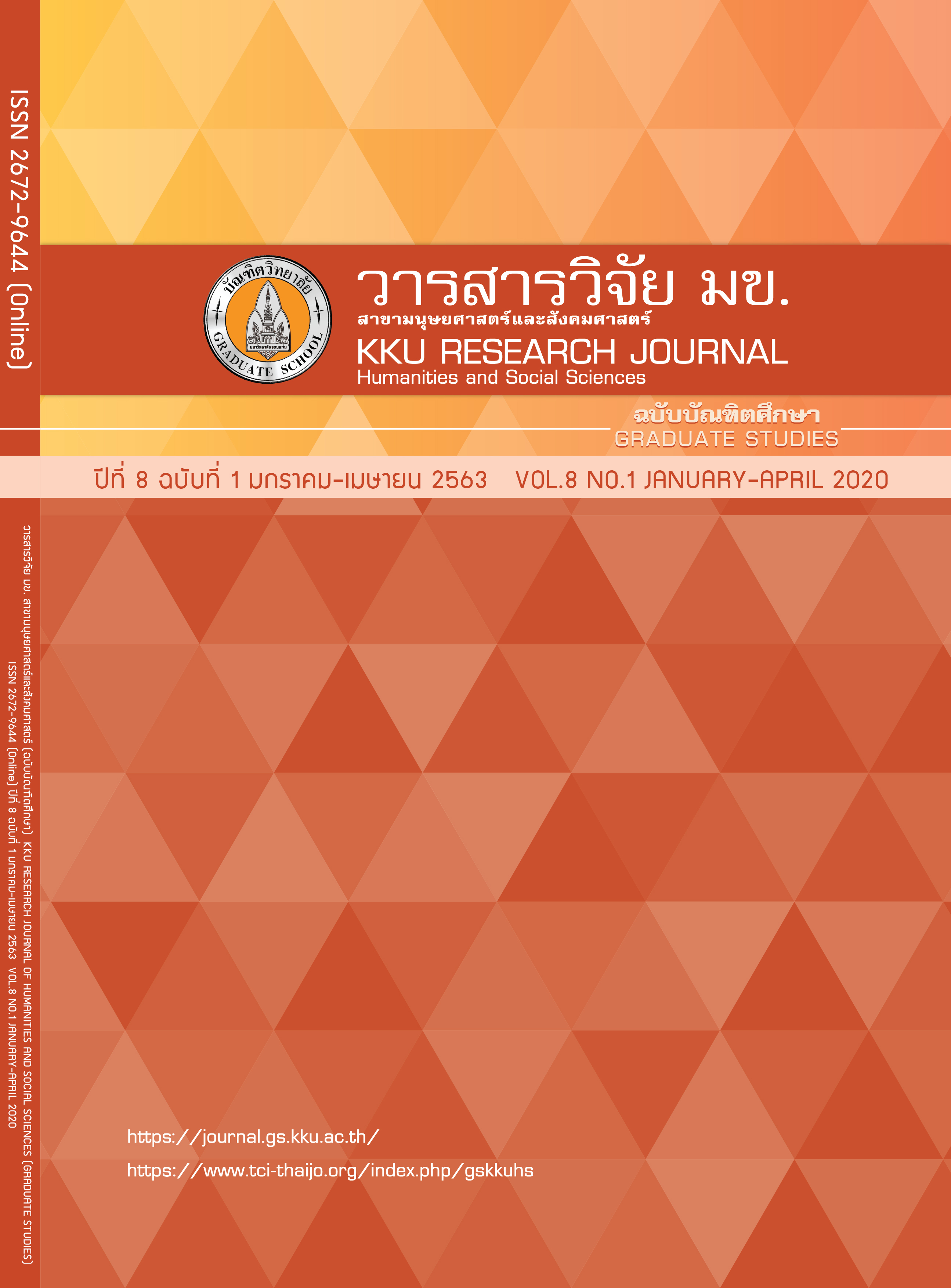Organizational Culture and Organizational Commitment of State-owned Commercial Bank Employees in Vientiane Capital, Lao PDR
Keywords:
Organizational culture, Organizational commitment, State-owned Commercial bank, Lao PDRAbstract
The objectives of this research were: 1) to study the relationship between the Organizational Culture and the Organizational Commitment; 2) to study the influence of the Organizational Culture on the Organizational Commitment of State-owned Commercial Bank Employees in Vientiane Capital, Lao PDR. The selected sample is the State-owned Commercial Bank employees. The collected data were based on 360 questionnaires. The data were analyzed using descriptive statistics that includes frequency and percentage. In addition, inferential statistics included Pearson’s Correlation Coefficient and Stepwise Multiple Regression were also used in this study. The results showed that Organizational culture was significantly correlated with organizational commitment at 0.05 level. The organizational culture factors that rendered influence on the organizational commitment showed the following results: Long term orientation, Indulgence vs. Restraint, and Uncertainty Avoidance at 0.01 level of significance. And Individualism and Collectivism showed a 0.05 level of significance, respectively
References
1995. Laos: 1-22.
2. Mach P, Guáqueta J. Utilization of the seven Ishikawa tools
(old tools) in the six sigma strategy. In Electronics Technology:
Concurrent Engineering in Electronic Packaging, 2001.
24th International Spring Seminar on 2001 (pp. 51-55). IEEE.
3. Klein HJ, and Park H. “Organizational Commitment.”
International encyclopedia of the social and behavioral sciences
2015; 2(17): 334-340.
4. Steers RM. Antecedents and outcomes of organizational
commitment. Administrative science quarterly 1977: 46-56.
5. Cohen A. Commitment before and after: An evaluation and
reconceptualization of organizational commitment. Human
resource management review 2007; 17(3): 336-354.
6. Gamble J, Huang Q. Organizational commitment of
Chinese employees in foreign-invested firms: Organizational
commitment of Chinese employees in foreign-invested firms.
The international journal of human resource management
2008; 19(5): 896-915.
7. Rizvi SZ, Waseem M, Nisar A, Naqvi SK, Ehsan N. Effects
of organizational culture on psychology of employee commitment.
Industrial Engineering and Engineering Management (IE&EM),
2011 IEEE 18Th International Conference on 2011 Sep 3
(pp. 2049-2053). IEEE.
8. Nazir NA. Person-culture fit and employee commitment
in banks. Vikalpa 2005 Jul; 30(3): 39-52.
9. Cameron KS, Quinn RE. Diagnosing and changing
organizational culture: Based on the competing values
framework. John Wiley & Sons; 2006 Mar 29.
10. Bank of the Lao PDR. Bank information in Laos (Internet).
2016a (cited 2018 January 5). Available from: www.bol.gov.la.
11. Armstrong M, Taylor S. Armstrong's handbook of human
resource management practice. 2014, Kogan Page Publishers.
12. Daft R. Organization theory and design: Nelson Education.
ISBN. 2012; 13: 9781111221294.
13. Mowday, RT, Steers RM, Porter LW. The measurement
of organizational commitment. Journal of vocational behavior
1979; 14(2): 224-247.
14. Meyer JP, Allen NJ. A three-component conceptualization of
organizational commitment. Human resource management
review. 1991 Mar 1; 1(1): 61-89.
15. Messner, W. Effect of organizational culture on employee
commitment in the Indian IT services sourcing industry.
Journal of Indian Business Research 2013; 5(2): 76-100.
16. Fischer R, Mansell A. Commitment across cultures:
A meta-analytical approach. Journal of International
Business Studies 2009; 40(8): 1339-1358.
17. Meyer JP, Stanley DJ, Jackson TA, McInnis KJ, Maltin ER,
Sheppard L. Affective, normative, and continuance commitment
levels across cultures: A meta-analysis. Journal of Vocational
Behavior 2012; 80(2): 225-245.
18. Afaneh JA, Khaireddin MA, Sanjuq GM, Qaddoumi JB.
Impact of cultural dimensions according to Hofstede model
on organizational commitment of the middle management
at Jordanian private universities. European Journal of
Business and Social Sciences 2014 Dec; 3 (9): 129-46.
19. Likitpiriya N. “Relationships between Organizational
Commitment with Organizational Culture and Quality of
Work Life of Employees, TOSHIBA CARRIER (THAILAND)
CO., LTD.” Master of Business Administration, Major Field:
Business Administration, Faculty of Business Administration
2014. Thai.
20. Hofstede G. Dimensionalizing cultures: The Hofstede
model in context. Online readings in psychology and culture
2011; 2(1): 8.
21. Silpjaru T. Research and analysis of statistical data with
SPSS and AMOS. ed. 15th. Nonthaburi: S.R. printing mass
products; 2014.
22. Chuan CL, Penyelidikan J. Sample size estimation using
Krejcie and Morgan and Cohen statistical power analysis:
A comparison. Jurnal Penyelidikan IPBL 2006; 7(1): 78-86.
23. Rose S, Spinks N, Canhoto AI. Tests for the assumption
that a variable is normally distributed. Management research:
Applying the principles. 2015.
24. HINKLE, Dennis E.; WIERSMA, William; JURS, Stephen G.
Correlation: a measure of relationship. Applied statistics for
the behavioral sciences 1998; 4: 105-131.



